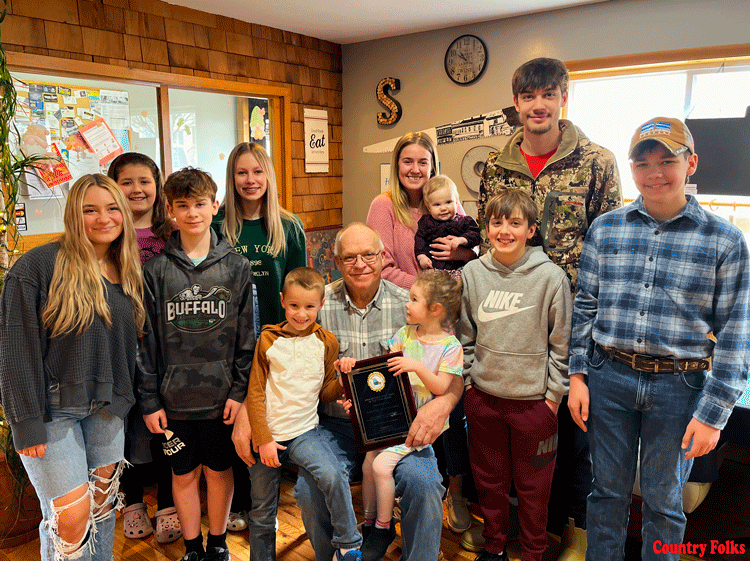 by Deborah Jeanne Sergeant
by Deborah Jeanne Sergeant
SYRACUSE, NY — Of course you want more people to buy beef if you’re a cattleman; however, not every producer is an “agvocate,” according to Jean O’Toole, executive director of the New York Beef Council. O’Toole spoke at the recent New York Farm Show on the topic.
She said how consumers read labels influences beef sales. For producers selling retail, “presentation is everything” rings true.
Most shoppers look at the color of meat and marbling, for example.
“Consumers notice labels,” O’Toole said, “the color of meat, marketing health claims, weight, price, beef brands and label claims, like the name of the company, how the animal is fed, antibiotic and hormone claims, grade, breed, natural, minimally processed and the website. It gets confusing to the consumers.”
She added that “humanely raised” claims are becoming more important to shoppers.
“People read about it here,” she said, gesturing to her smartphone, “and that’s what they’re thinking about when they shop.”
Other label elements may include antibiotics, pasture raised, hormone-free, free range, source verified, grain finished, grass finished, grass fed, and natural.
She said many producers and processors fear they’ll lose sales if they don’t include as much information as they can, since they think that consumers will assume the opposite is true if a claim is absent.
Many consumers are looking for local products to build trust.
O’Toole said producers should get back to basics, like the cuts and quality grades: USDA Prime, USDA Choice and USDA Select.
“Three percent of all animals are Prime, but you won’t see it in grocery stores, just butcher shops,” O’Toole said.
She believes there’s a disconnect between producers and consumers; however, the variety of beef available — from conventional to grass finished to grain finished — only helps the industry.
“It’s great because we have variety so we can get more beef on the plate,” O’Toole said. “If we have no beef on the plate, they’ll replace it with another protein option.”
With beef demand and prices increasing, the industry is in a good position. Part of the rise in demand has to do with the change in public perception. After decades of discouraging beef consumption after linking it with increased cholesterol, the health industry’s research has finally cleared beef and implicated inflammation as causing high cholesterol.
O’Toole said that’s why consumer information is really important. In addition, many people “don’t know what cut is what,” she said.
She stressed to attendees to emphasize beef’s versatility, flavor and nutritional quality, such as zinc, iron and protein.
“We need to emphasize to consumers that all meat is GMO-free,” O’Toole said. “No matter what they eat, all meat is GMO-free.”
The only GMO products grown from GMO seeds that are commercially available in the U.S. are alfalfa, canola, corn, cotton, papaya, potatoes, soybeans, squash and sugar beets.
O’Toole said producers should also stress that beef is safe, anti-biotic free, humanely raised, nutritious and “something we can be proud of.”
Producers should avoid making health claims they cannot back up and also comparative statements that compare their beef to that of other farms or that which is found in retail stores.
“It’s all about taste and personal preference,” O’Toole said. “We need to play nice and not diminish one another. My job is to increase beef demand.
“What if something happens to erode public trust in beef? We need to band together as beef producers.”
The Beef Checkoff, part of the 1985 Farm Bill, is the state-based, mandatory marketing program, receives $1 every time a bovine sells. The state keeps $.50 and forwards the remaining $.50 to the Beef Board.
O’Toole said the Checkoff is “a catalyst for change designed to stimulate the supply chain to sell more beef and consumers to buy more beef.”
The Checkoff does this through a series of state and national initiatives in six program areas: promotion, research, consumer information, industry information, foreign marketing and producer communications.
But the Checkoff cannot influence government policy or action, including lobbying; engage in unfair or deceptive practices; or reference any particular brand or trade name without prior approval by CBB and USDA.
The New York Beef Quality Assurance designation indicates certification in the program. O’Toole said anyone who influences the quality of cattle, including owners, farm workers, junior producers, animal science students and allied industry partners may become certified. The designation indicates dedication to animal wellbeing, herd health, herd performance and beef quality.
O’Toole also mentioned the Masters of Beef Advocacy. This “MBA” program is a self-paced, online program to help beef producers, youth and those associated with the industry to know what they need to do to advocate for the industry. Its five courses include The Beef Community, Raising Cattle on Grass, Life in the Feedyard, From Cattle to Beef and Beef: It’s What’s for Dinner.
She said the MBA especially helps producers who sell directly to consumers.











Leave A Comment